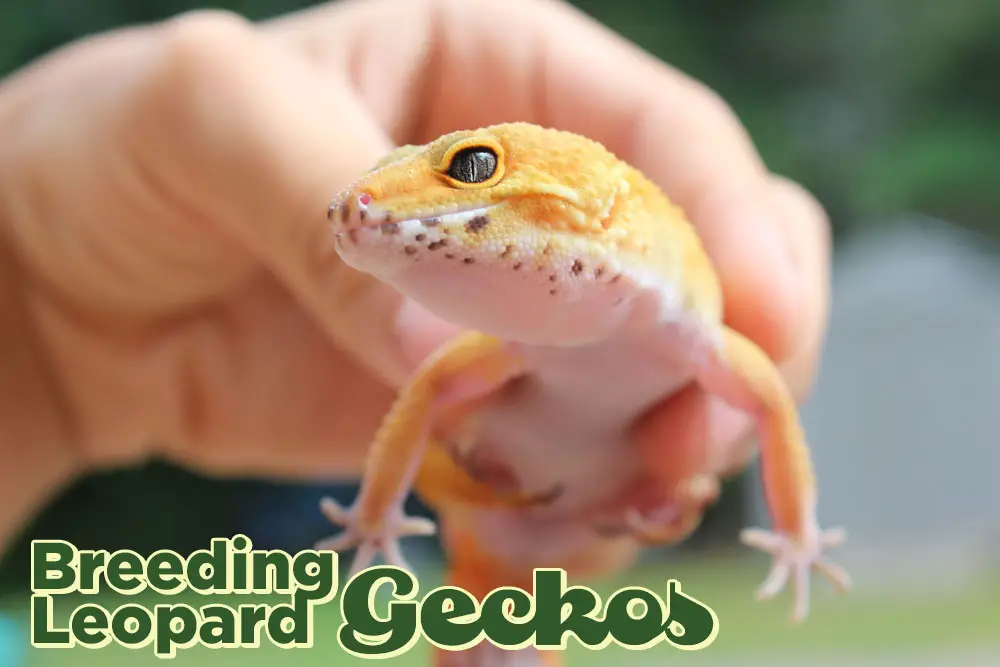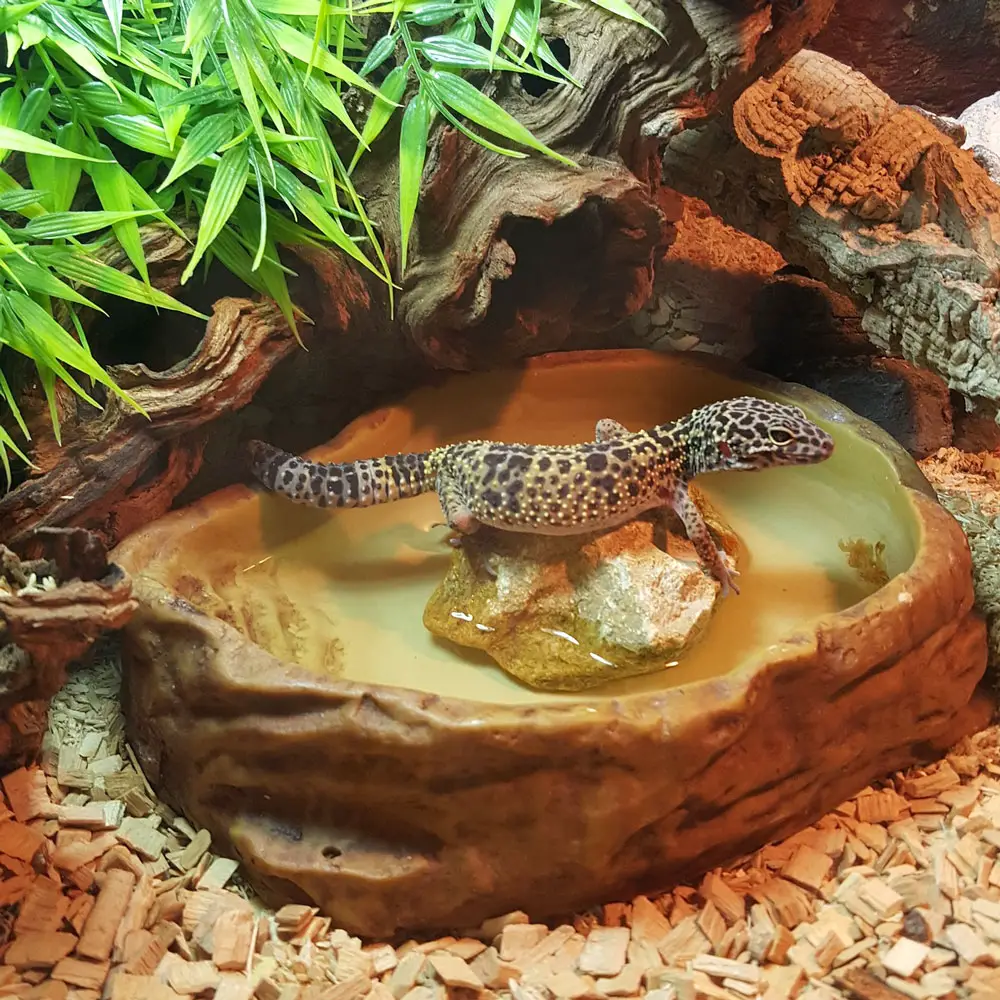If you love leopard geckos and have a growing collection, you might be curious about how to breed them. If this is you, I have you covered! In this article, I do a pretty deep dive and have included some tips and advice from a vet and some veteran leopard gecko breeders about the right ways to successfully breed them. Here’s what I learned.

To breed leopard geckos, choose those that are healthy and sexually mature. Provide a good environment, such as setting up proper lighting with a UVB lamp, setting the temperature between 70 and 75 degrees Fahrenheit, and controlling the humidity at 70 to 100 percent.
If you consider breeding leopard geckos, it is important to do your research and make sure that you are prepared. In this article, we did the research for you. Keep on reading and embark on this exciting journey.
Choosing the Right Leopard Geckos for Breeding
Leopard geckos reach sexual maturity at 18 to 24 months. Avoid breeding leopard geckos earlier than this age range to prevent health issues, as they may not be healthy enough to breed. Make sure both male and female leopard geckos are healthy and free from any disease before mating. Check out the factors below that show signs of healthy leopard geckos.
- Good Appetite: Healthy leopard geckos display a good appetite and eat at least twice daily.
- Active: They tend to be active and curious by exploring their enclosure and interacting with their surroundings.
- Healthy Skin: Your leopard geckos are characterized by smooth skin and are free of blemishes. The skin color varies depending on the morph of the gecko.
- Clear and Bright Eyes: Eyes must be clear and bright, not sunken or cloudy.
- Tail: The tails should be plump and well-proportioned to their body.
- Waste: The appearance should be firm and formed and not watery.
- Behavior: Leopard geckos should be alert and responsive to their surroundings without signs of illness or stress.
Setting Up the Appropriate Breeding Environment
The breeding environment affects the success of the mating process. Below, we will discuss the different factors to address for an ideal breeding environment.

Providing the Right Enclosure and Terrariums
An ideal terrarium size should have a dimension of 60 cm long, 40 cm high, and 30 cm deep. It will give enough space for them to move around and breed. The enclosure must have a secure screen top to allow the entry of fresh air while keeping them from escaping.
Also, place plenty of hiding places because leopard geckos tend to be shy. You can utilize rocks and cork bark to create their hiding places. In choosing a substrate, pick do not pick sand or soil! This is a common misconception that since they are desert dwellers this would be the most comfortable for them.
But actually, they originate from Afghanistan, Iran, and Iraq where there is hard dry ground and rocky terrain. This is more suitable for them. A sandy substrate could be ingested by your gecko and could result in catastrophic health problems. Go with a course substrate such as bamboo chips etc. shown above.
Correct Temperature and Humidity Control
The temperature should sit between 70 and 75 degrees Fahrenheit because it encourages breeding activity. Keep it at the same temperature for four to six weeks. When it comes to humidity control, it should be 70 to 100 percent humidity inside the terrarium. A humid hiding place is a must because this is where the female gecko lays her eggs.
Humidity control plays a crucial part in the breeding process. If the humidity falls below the ideal level, the female leopard gecko may not lay eggs. On the other hand, too high humidity allows the development of fungus that dries out the eggs.
Setting up the Proper Lighting
A combination of a heat lamp and a UVB lamp provides proper lighting in the breeding environment. A heat lamp helps the leopard gecko maintain its body temperature. It must be placed on one side of the enclosure and the thermostat on the other side to create a gradient of temperature.
A UVB lamp or the ultraviolet B lamp helps leopard geckos to synthesize vitamin D. Vitamin D allows calcium absorption that will keep your pet healthy. Make sure to use a UVB lamp specifically designed for reptiles and place it at least 6 inches from the leopard geckos. Lastly, expose your pet to a UVB lamp for a maximum of 12 to 14 hours.
Proper Nutrition for Breeding Leopard Geckos
Leopard geckos should eat a diet high in protein while breeding. You can use protein sources from crickets, waxworms, mealworms, and Dubia roaches. Supplement their protein diet with calcium and vitamin D3. The females need calcium for egg production. Calcium provides strength and rigidity for the shell of the eggs.
Vitamin D3 helps calcium absorption. Dust their food with calcium and vitamin D3 powder to supplement their diet. Feed them foods with supplements twice a day.
Understanding the Reproduction of Leopard Geckos
As a responsible and informed pet owner, taking the time to learn about leopard gecko reproduction ensures the health and well-being of the pets involved.
Mating Behavior and Signs of Readiness
Both male and female leopard geckos exhibit easily recognizable gestures to indicate their willingness to mate:
- A male leopard gecko bobs his head and vibrates his tail to attract the female leopard gecko and assert dominance.
- Also, a male leopard gecko secretes a hormone known as pheromones to signal the female that he is ready to mate.
- A female leopard gecko becomes more active and may start to lose her appetite.
- A bulge at the base of a female leopard gecko starts to develop. The eggs form here.
Female Reproductive Cycle and Ovulation
The ovulation cycle of a female leopard gecko starts from January to September. After mating, the female ovulation occurs after 24 hours. She will start laying eggs in a nesting box for about four to seven weeks. Make sure to provide a nesting box filled with substrate and keep it moist but not wet.
Also, increase the amount of calcium in her diet. Pay close attention to your female leopard gecko during her reproductive cycle because she becomes more susceptible to illnesses like metritis, egg binding, or pregnancy toxemia.
Breeding Process
Breeding Leopard geckos, mainly involves three processes – introducing the leopard geckos, monitoring their mating behavior, and recognizing successful copulation.
Introducing Male and Female Geckos
Put the male leopard geckos in a separate enclosure from the female and place both enclosures next to each other. It allows them to familiarize themselves with each other’s scent. After two to three days, you can introduce them in a neutral enclosure. A neutral enclosure is an enclosure that neither has claimed as their territory.
Monitor any signs of aggression. Immediately separate them if they start to fight. Otherwise, you can leave them overnight. After their introduction, monitor them closely for any signs of mating behavior.
Recognizing Successful Copulation and Signs of a Pregnant Leopard Gecko
You may struggle to tell if they had a successful mating session. However, a few signs may help indicate that copulation occurred:
- For several minutes, a male leopard gecko stays on top of the female.
- A female gains weight as the eggs develop.
- The vent, or backend where they eliminate waste, becomes darker.
- A female leopard gecko becomes less active as she gets closer to laying eggs.
- She will start looking for a place to lay eggs.
Of course, if the female Leopard Gecko is pregnant eventually she will lay her eggs! She may then also become aggressive in the attempt to protect them.
In some cases, not all of these signs will be present. Consult a vet to make sure your leopard gecko is pregnant.
Leopard Gecko Egg Laying Behavior
In addition to the signs you are looking for just to know if your leopard gecko is pregnant, below are some further behaviors you may notice both when she’s preparing to lay her eggs and once they have been laid. Make sure to monitor her closely during this time:
- A female leopard gecko will start to look for a nesting place. It could be a hide box, a piece of fabric, or in the corner of the enclosure.
- She will dig a shallow hole in the substrate where she will lay her eggs.
- She will cover the eggs with a substrate. It helps keep the egg warm and moist.
- She will stay close to her eggs for a few days to protect them from predators.
How Long Are Leopard Geckos Pregnant For?
The gestation period of a female leopard gecko takes two weeks before she lays the eggs. This means it will take two weeks for the eggs to develop inside her body. The eggs will hatch at about 45 to 53 days. The temperature in the first two weeks of the incubation period controls the gender of the offspring!
Interesting Fact: The temperature range between 85 to 87 degrees Fahrenheit results in equal chances of producing males and females. When the temperature drops to 79 degrees Fahrenheit, the offspring are mostly female! On the other hand, temperatures of 90 degrees Fahrenheit will result in male offspring!
If you are successful in breeding Leopard Geckos, this might be sort of a “leveling up” to see if you could impose this kind of control over your results!
Leopard Gecko Laying Eggs Without Mating
A female Leopard gecko can lay eggs without mating – it’s known as parthenogenesis. Parthenogenesis commonly happens to captive leopard geckos when no males are present. In this rare phenomenon, the eggs get fertilized by their own egg cells. However, the eggs are typically infertile.
Remember that leopard geckos can store sperm to lay multiple egg batches. If ever your leopard gecko lays eggs without mating, it may be because she stored up sperm cells from a previous mating session. A female leopard gecko can retain the sperm in her body for almost a year. It’s important to take note of this before assuming the eggs are a product of parthenogenesis.
How to Tell if Leopard Gecko Eggs are Fertile
The most common way to determine if the eggs are fertile is by using the candling method. You need to utilize a bright light source, such as a small LED flashlight, and shine it through the egg. If you see a dark spot inside the egg, it’s a good indication that the embryo is developing.
Of course, just waiting for the eggs to hatch will tell the story. If the eggs don’t hatch after 60 days, the eggs are most likely infertile. Also, fertile eggs are usually plump and firm when touched.
What To Do with Infertile Leopard Gecko Eggs
Several factors lead to eggs becoming infertile. Let’s start with poor health. If a leopard gecko gets malnourished or sick, its eggs may become infertile. The other reason may be improper incubation. Temperature and humidity that are too high or too low result in infertile eggs.
If you happen to with some certainty identify infertile eggs, what should you do? The easiest and most straightforward approach is to discard them. Be sure to dispose of the eggs responsibly. You can also give them away to a reptile rescue or an animal shelter that accepts reptile eggs for educational purposes. Inform them that the eggs are infertile.
Incubation Process
Follow these steps to ensure the health and survival of the hatchlings:
- Prepare the incubation container. It should be a clear plastic box with a lid. The bottom of the box must be lined with moist but not wet substrate. Use a commercial incubation medium.
- Place the eggs in the incubation container with the blunt end facing down. Leave a gap of an inch between the eggs and the sides of the container.
- Set the temperature of the incubation container to 82 to 84 degrees Fahrenheit. As mentioned earlier, the humidity level must be 70 to 100 percent.
- Monitor the eggs daily. See signs of dark spots by using the candling method.
- The eggs should hatch after 60 days. Remove the hatchlings from the incubation container and place them in their own enclosure.
Conclusion
Leopard geckos are relatively easy to breed. However, it’s crucial to do your research and understand the process before you start breeding. Remember to consider the sexual maturity and health of your pets ahead of time. Provide them with an ideal environment for breeding, and follow the correct incubation steps I mentioned above. Closely monitor their behavior during their reproduction cycle. That way, you can ensure the success and well-being of your pet leopard geckos throughout the mating process. And please, always breed responsibly!
Sources
Vet Folio–Leopard Gecko Husbandry, Nutrition, and Breeding
rspca.org
everythingreptiles.com-substrate considerations
vetfolio.com–temperature and humidity considerations
vetfolio.com–gestation considerations

